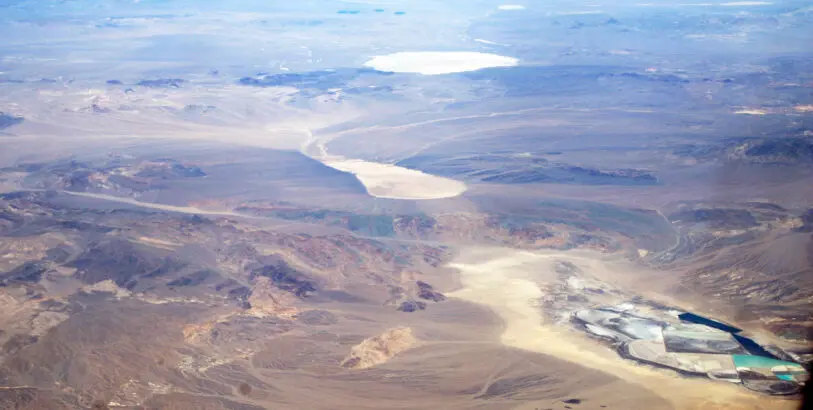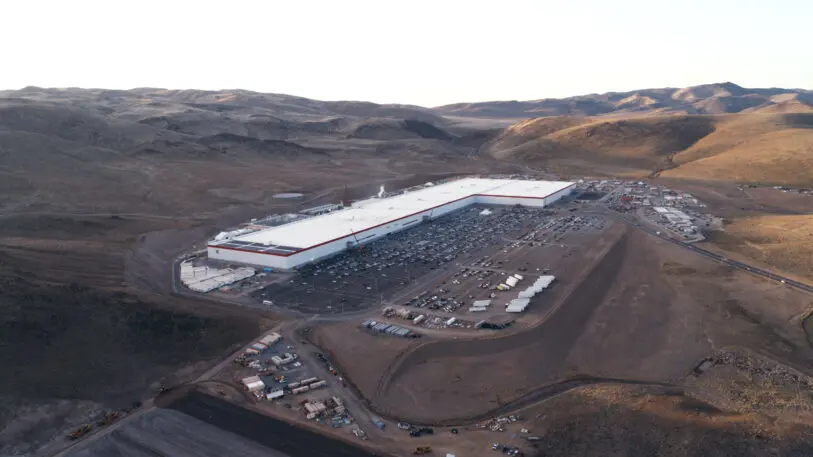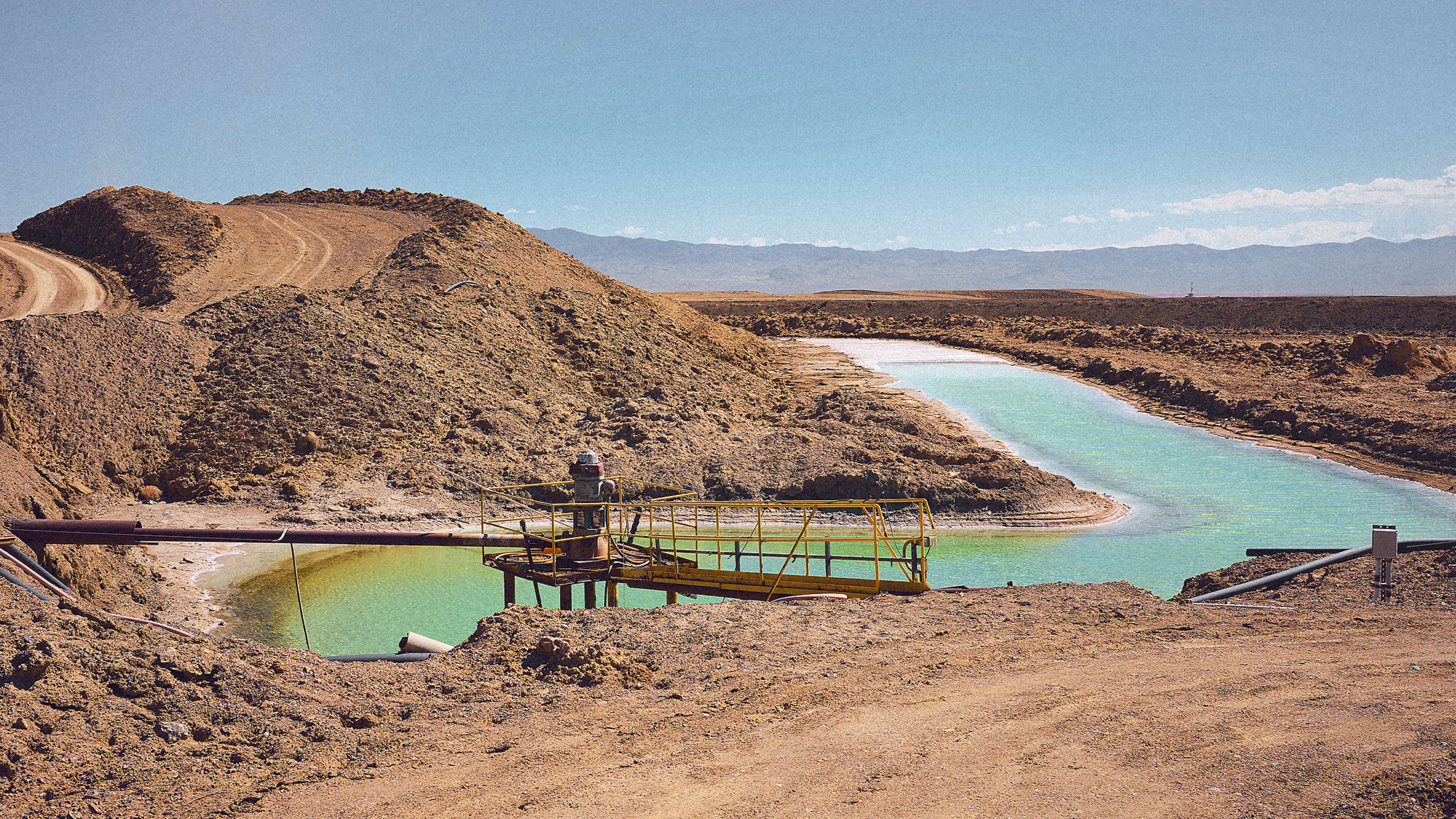I’m driving through the desert valley on a summer afternoon to see the workings of this latest mining boom. I ask my phone to direct me to the perimeter of the lithium ponds, and it replies from its awkward perch on the dashboard, tethered by a white USB cable. Silver Peak, Nevada’s large, dry lake bed, was formed millions of years ago during the late Tertiary Period. It’s surrounded by crusted stratifications pushing up into ridgelines containing dark limestones, green quartzites, and gray and red slate.
Lithium was discovered here after the area was scoped for strategic minerals like potash during World War II. This soft, silvery metal was mined in only modest quantities for the next 50 years, until it became highly valuable material for the technology sector.
In 2014, Rockwood Holdings, a lithium mining operation, was acquired by the chemical manufacturing company Albemarle Corp. for $6.2 billion. It is the only operating lithium mine in the United States. This makes Silver Peak a site of intense interest to Elon Musk and the many other tech tycoons for one reason: rechargeable batteries. Lithium is a crucial element for their production.
Smartphone batteries, for example, usually contain about three-tenths of an ounce of it. Each Tesla Model S electric car needs about 138 pounds of lithium for its battery pack. These kinds of batteries were never intended to supply a machine as power hungry as a car, but lithium batteries are currently the only mass-market option available. All of these batteries have a limited life span; once degraded, they are discarded as waste.
About 200 miles north of Silver Peak is the Tesla Gigafactory. This is the world’s largest lithium battery plant. Tesla is the number-one lithium-ion battery consumer in the world, purchasing them in high volumes from Panasonic and Samsung and repackaging them in its cars and home chargers.
Tesla is estimated to use more than 28,000 tons of lithium hydroxide annually—half of the planet’s total consumption. In fact, Tesla could more accurately be described as a battery business than a car company. The imminent shortage of such critical minerals as nickel, copper, and lithium poses a risk for the company, making the lithium lake at Silver Peak highly desirable. Securing control of the mine would mean controlling the U.S. domestic supply.

But for the majority of cases, charging an electric car necessitates taking power from the grid, where currently less than a fifth of all electricity in the U.S. comes from renewable energy sources. So far none of this has dampened the determination of auto manufacturers to compete with Tesla, putting increasing pressure on the battery market and accelerating the removal of diminishing stores of the necessary minerals.
Global computation and commerce rely on batteries. The term artificial intelligence may invoke ideas of algorithms, data, and cloud architectures, but none of that can function without the minerals and resources that build computing’s core components. Rechargeable lithium-ion batteries are essential for mobile devices and laptops, in-home digital assistants, and data center backup power. They undergird the internet and every commerce platform that runs on it, from banking to retail to stock market trades.
Many aspects of modern life have been moved to “the cloud” with little consideration of these material costs. Our work and personal lives, our medical histories, our leisure time, our entertainment, our political interests—all of this takes place in the world of networked computing architectures that we tap into from devices we hold in one hand, with lithium at their core.

The full-stack supply chain of AI reaches into capital, labor, and Earth’s resources—and from each, it demands an enormous amount. The cloud is the backbone of the AI industry, and it’s made of rocks and lithium brine and crude oil.
In his book A Geology of Media, theorist Jussi Parikka suggests we think of media not from Marshall McLuhan’s point of view—in which media are extensions of the human senses—but rather as extensions of Earth. Computational media now participate in geological (and climatological) processes, from the transformation of the Earth’s materials into infrastructures and devices to the powering of these new systems with oil and gas reserves.
Reflecting on media and technology as geological processes enables us to consider the radical depletion of nonrenewable resources required to drive the technologies of the present moment. Each object in the extended network of an AI system, from network routers to batteries to data centers, is built using elements that required billions of years to form inside the Earth.

The Consumer Technology Association notes that the average smartphone life span is a mere 4.7 years. This obsolescence cycle fuels the purchase of more devices, drives up profits, and increases incentives for the use of unsustainable extraction practices. After a slow process of development, these minerals, elements, and materials then go through an extraordinarily rapid period of excavation, processing, mixing, smelting, and logistical transport—crossing thousands of miles in their transformation.
What begins as ore removed from the ground, after the spoil and the tailings are discarded, is then made into devices that are used and discarded. They ultimately end up buried in e-waste dumping grounds in places like Ghana and Pakistan. The life cycle of an AI system from birth to death has many fractal supply chains: forms of exploitation of human labor and natural resources and massive concentrations of corporate and geopolitical power. And all along the chain, a continual, large-scale consumption of energy keeps the cycle going.
The extractivism on which San Francisco was built is echoed in the practices of the tech sector based there today. The massive ecosystem of AI relies on many kinds of extraction: from harvesting the data made from our daily activities and expressions to depleting natural resources and exploiting labor around the globe so that this vast planetary network can be built and maintained. And AI extracts far more from us and the planet than is widely known.
Kate Crawford is a leading scholar of the social and political implications of artificial intelligence. She is a research professor at the USC Annenberg School for Communication and Journalism, a senior principal researcher at Microsoft Research, and the inaugural chair of AI and Justice at the École Normale Supérieure in Paris. This article was adapted with permission from Atlas of AI (Yale University Press, 2021). Buy a copy here.
Recognize your brand’s excellence by applying to this year’s Brands That Matter Awards before the early-rate deadline, May 3.
